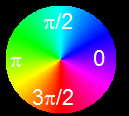Ultracold atoms
With the aid of a laser, researchers were recently able to cool tiny quantities of matter (less than one million atoms) to extremely low temperatures, very close to the “absolute zero”. At these temperatures, the laws of quantum mechanics apply and atoms behave as waves. In an “atom interferometer” the two-slit experiments by Young is performed with matter rather than light.
 In our work we study the interference between two Bose-Einstein condensates, initially prepared in a non-equilibrium state. In the picture on the left, the colors indicate the predicted phases of two condensates at the beginning of the experiment and the wavy lines the resulting interference fringes. Click here to see the movie. The experiment that we proposed is currently being realized in the group by Joerg Schmiedmayer.
In our work we study the interference between two Bose-Einstein condensates, initially prepared in a non-equilibrium state. In the picture on the left, the colors indicate the predicted phases of two condensates at the beginning of the experiment and the wavy lines the resulting interference fringes. Click here to see the movie. The experiment that we proposed is currently being realized in the group by Joerg Schmiedmayer.
Online References:
[1] EGDT, E.Berg, E.Altman “Hidden order in 1D Bose insulators”, Phys. Rev. Lett. 97, 260401 (2006)
See also Science paper by M. Endres etal, “Observation of Correlated Particle-Hole Pairs and String Order in Low-Dimensional Mott Insulators”
[2] E.Berg, EGDT, E.Altman, “Rise and fall of hidden string order of lattice bosons”
Phys. Rev. B 77, 245119 (2008)
[3] EGDT, E. Demler, A. Polkovnikov, “Universal rephrasing dynamics after a quantum quench via sudden coupling of two initially independent condensates, Phys. Rev. Lett. 101, 090404 (2013)
[4] EGDT, “Dynamical probing of a topological phase of bosons in one dimension”
Phys. B: At. Mol. Opt. Phys. 46, 085303 (2013)
[5] R. Uzdin, EGDT, R. Kosloff, N. Moiseyev, “A third-order exceptional point effect on the dynamics of a single particle in a time-dependent harmonic trap”, Phys. Rev. A 88, 022505 (2013)


